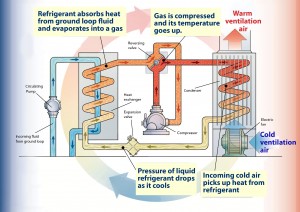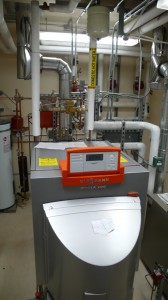A ground source heat pump (GSHP) is a space heating appliance that uses electricity to convert geothermal heat to a temperature that can be used for indoor heating. They are common in the Lower 48 and quite popular in Europe. There are also several GSHP systems in Alaska, including commercial systems at the Juneau Airport, Weller Elementary School in Fairbanks, and the Alaska SeaLife Center in Seward. Fairbanks has more than 10 residential systems as well.
In the winter, ground source heat pumps work like refrigerators in reverse. Instead of taking heat from the inside of the refrigerator and rejecting it outside, a GSHP gathers heat from the ground, steps it up to a higher temperature using a compressor, and then “rejects” it inside a house. In the summer, some GSHPs can run in reverse mode to provide air conditioning – taking heat from a house and rejecting it to the ground. The main “fuel” for a GSHP is geothermal energy, but it uses electricity to run the compressor. Since the electricity is only acting to boost the geothermal heat (which is free), heat pumps are more efficient than electric heating appliances.
A GSHP consists of 3 parts: the ground loop, the heat pump and the distribution system. The ground loop gathers heat from the ground. It consists of loops of pipes buried in horizontal troughs or vertical boreholes. A pump moves a fluid through the pipes. As the fluid travels, it is warmed up by geothermal heat from the soil and returns to the heat pump with a higher temperature than when it left. Back at the heat pump, the fluid from the ground loop passes its heat to a refrigerant, causing it to evaporate into a gas. The refrigerant fluid then passes through a compressor and its heat can be “stepped up” before it transfers the heat to air or water for the distribution system. Heat pumps can work with a forced air distribution system or a radiant hydronic distribution system, however they generally are not capable of producing hot enough water for baseboard hydronic systems.
Ground source heat pumps are considered a partially renewable technology, because the heat they take from the ground comes from solar and geothermal sources. They are entirely renewable if the electricity they use comes from a renewable source, such as solar or wind. Heat pumps are also very safe to operate, because there is no combustion. They can, however, be expensive to install because you have to excavate land or drill to establish the ground loop. Talk to an installer if you think a GSHP might be right for you.
For more information on ground source heat pumps, see a report by the Cold Climate Housing Research Center and the Alaska Center for Energy and Power: http://cchrc.org/docs/reports/Ground-Source-Heat-Pumps-in-Cold-Climates.pdf. It covers the performance, cost and payback of GSHPs in various regions of Alaska.

